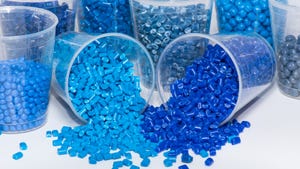Manufacturing slow down and contraction in consumer spending take their toll.
June 8, 2023

Zachary Moore
Demand for both polyethylene (PE) and polypropylene (PP) remained sluggish in May amid weaker manufacturing activity and slower consumer spending. Overall GDP figures are higher year on year, mostly bolstered by increases in service spending, although demand for manufactured goods is soft.
PP contracts mostly followed propylene monomer contracts lower by 8 cents/lb. May PE contract negotiations are ongoing, with buyers seeking a price reduction while sellers are hoping to settle at a rollover.
PP resin sales fall almost 10% since start of year
Domestic PP resin sales fell 9.7% during the first four months of 2023 compared with the same period of the prior year. PE sales to the domestic market were down 8.9% year on year for high-density polyethylene (HDPE), 9.9% for linear-low-density polyethylene (LLDPE), and 11% for low-density polyethylene (LDPE), according to data from the American Chemistry Council (ACC) and Vault Consulting.
Spot resin pricing was flat to lower for both PP and PE month on month, with spreads between PP and propylene monomer dipping to around 10 to 12 cents/lb for generic Prime, while spot export PE prices had a month-on-month decline of around 4 to 6 cents/lb.
Force majeure lifted
Supply levels are sufficient to long, with the lifting at the end of May of a PE force majeure declared earlier in the year. PP inventories rose for a fourth consecutive month in April, even with average industry operating rates standing at 72%. PP operating rates have remained below 80% for the past nine consecutive months.
PE run rates also fell, although PE operating rates have found support from export sales, allowing PE operating rates to remain above 80% for LDPE and above 90% for HDPE and LLDPE. Exports as a percentage of overall sales remained above the 40% threshold for a fourth consecutive month, as the US remains one of the lowest cost producing regions based on integrated ethylene economics.
PP exports increase
PP resin exports have also increased year on year and are now coming in at around 10% of total sales. Export volumes had been negligible during 2021 and 2022. Expanding capacity and slower domestic demand have pushed increased volumes into the export market, even though export netbacks are weak.
Bayport Polymers’ new PE plant began startup activities in late May, while Shell’s new ethylene and PE complex in Pennsylvania resumed operations following the conclusion of litigation surrounding emissions from the plant. Nova’s new PE plant is anticipated to start up around late July, rounding out the current crop of new PE expansions.
About the author
|
Zachary Moore has 14 years of experience researching and analyzing the petrochemical markets. His primary area of expertise is in commodity polymers, but he has also covered olefins, aromatics, and intermediate chemicals used in polyurethanes. Moore returned to the United States in 2016 after working overseas for 10 years in Asia and Europe and has been responsible for covering the North American polyolefins market since 2017.
ICIS, a division of RELX, is a trusted source of global commodity intelligence for the energy, chemical, and fertilizer industries. The firm helps businesses make strategic decisions, mitigate risk, improve productivity, and capitalize on new opportunities through a global team of more than 600 experts. RELX is a global provider of information-based analytics and decision tools for professional and business customers. The group serves customers in more than 180 countries and has offices in about 40 countries. It employs more than 33,000 people, over 40% of whom are based in North America.
You May Also Like



